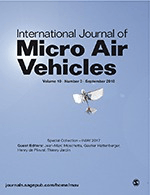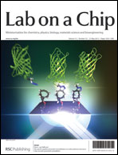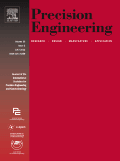
Micro and Nano Systems Letters
metrics 2024
Advancing Innovation in Micro and Nano Systems
Introduction
Micro and Nano Systems Letters, published by SPRINGERNATURE, is a prominent peer-reviewed journal dedicated to advancing the field of micro and nanosystems, with a special focus on biomaterials and biomedical engineering. Since its inception in 2013, this Open Access journal has provided a vital platform for researchers and practitioners to disseminate innovative findings and share insights that contribute to the growing body of knowledge in these rapidly evolving disciplines. With a remarkable impact reflected in its Q1 quartile rankings in both biomaterials and biomedical engineering, and impressive Scopus ranks placing it within the top tier of its fields, Micro and Nano Systems Letters plays a critical role in fostering collaboration and knowledge exchange among scientists and engineers worldwide. The journal is accessible globally, ensuring that research is widely disseminated and impacting a diverse audience to drive progress in technology and healthcare solutions.
Metrics 2024
 -
- 4.70
4.70 -
- -
-Metrics History
Rank 2024
IF (Web Of Science)
JCI (Web Of Science)
Quartile History
Similar Journals

International Journal of Micro Air Vehicles
Elevating Innovation in Micro Air Vehicle ResearchThe International Journal of Micro Air Vehicles, published by SAGE Publications Ltd, stands as a pioneering platform for cutting-edge research in the rapidly evolving field of micro air vehicle (MAV) technology. With an ISSN of 1756-8293 and an E-ISSN of 1756-8307, this journal caters to a diverse readership, including aerospace engineers, researchers, and industry professionals who are at the forefront of innovation in aerospace engineering. It holds a commendable position within the Q3 category of Aerospace Engineering for 2023 and is ranked 65th out of 153 in Scopus, placing it in the 57th percentile among its peers. As a vital resource since its inception in 2010, the journal emphasizes advancements in design, performance, and applications of MAVs, while facilitating knowledge sharing and collaboration across disciplines. Although it operates on a subscription model, the journal ensures accessibility of pivotal research findings for professionals and scholars alike, aiming to shape the future of aerospace applications through rigorous academic inquiry.

Micromachines
Connecting ideas and technologies in the realm of micromachines.Micromachines, published by MDPI, is a premier open-access journal that has been advancing the field of engineering since its inception in 2010. With a focus on the integration of micro- and nano-scale technologies, the journal encompasses a broad spectrum of disciplines, specifically in Control and Systems Engineering, Electrical and Electronic Engineering, and Mechanical Engineering, reflected in its commendable Q2 quartile rankings across these categories as of 2023. Operating from the heart of Switzerland, Micromachines provides a platform for researchers, professionals, and students to disseminate innovative research that explores the cutting-edge of micromachine technology and its applications across various industries. With an impressive Scopus ranking, showcasing its influence and reach – 74th percentile in Mechanical Engineering, 70th in Control and Systems Engineering, and 68th in Electrical and Electronic Engineering – this journal is invaluable for those seeking to contribute to and stay informed about the advancements in micromachine research. The open-access format ensures that groundbreaking discoveries are readily available to a global audience, fostering collaboration and intellectual discourse within the scientific community.

Biomedical Engineering Letters
Fostering collaboration for innovative biomedical solutions.Biomedical Engineering Letters, published by SpringerNature, is a prominent journal in the field of Biomedical Engineering. With a robust ISSN of 2093-9868 and E-ISSN of 2093-985X, this esteemed journal has established itself as a vital resource for researchers and professionals seeking to advance their knowledge and share groundbreaking findings. Recognized for its quality, Biomedical Engineering Letters holds a distinguished ranking in Scopus, positioned at #94/303 (69th percentile) in the Biomedical Engineering category. The journal covers a diverse scope within biomedical engineering, providing an important platform for innovative research from 2011 to 2024 and facilitating the exchange of ideas among scholars. Although it operates under a subscription model, the journal's commitment to enhancing the field makes it an indispensable reference for those engaged in cutting-edge biomedical research in Germany and globally.

Micro and Nanostructures
Transforming Ideas into Innovative MaterialsMicro and Nanostructures is a leading academic journal published by Academic Press Ltd - Elsevier Science Ltd, focusing on the cutting-edge fields of biomaterials, condensed matter physics, and electronic, optical, and magnetic materials. With an impact factor reflecting its rising status, the journal has achieved remarkable rankings within its categories, including Q2 in Condensed Matter Physics and Electronic, Optical and Magnetic Materials, and Q3 in Biomaterials, as of 2023. Spanning from 2022 to 2024, Micro and Nanostructures presents integral research that advances the understanding and application of micro- and nanostructured materials, thereby playing a crucial role for researchers, professionals, and students alike. As an open access publication, it ensures broad accessibility to groundbreaking studies that shape the future of material science. The journal's commitment to high-quality research and its strategic positioning as a premier source of knowledge in its domain make it an essential platform for the dissemination of innovative ideas and discoveries.

INSTRUMENTATION SCIENCE & TECHNOLOGY
Transforming Insights into Instrumentation ExcellenceInstrumentation Science & Technology, published by Taylor & Francis Inc, is a leading journal in the fields of Chemical Engineering, Environmental Science, and Instrumentation. With an ISSN of 1073-9149 and an E-ISSN of 1525-6030, this established publication spans a rich history from 1968 to 1972, 1974 to 1977, 1979 to 1982, 1984 to 1990, and continuing through to 2024. Positioned in the Q3 category of its subject areas, it ranks competitively within the Scopus framework, notably achieving rank #103/233 in Environmental Science and #138/273 in Chemical Engineering. Aimed at researchers, professionals, and students, this journal serves as a crucial platform for advancing knowledge in instrumentation technologies and their applications across various disciplines. Although not an open-access journal, it provides valuable insights and peer-reviewed articles that are essential for staying at the forefront of instrumentation science.

Defence Technology
Pioneering Innovations in Defence MaterialsDefence Technology, an esteemed journal published by KEAI PUBLISHING LTD, stands at the forefront of innovation and research in the fields of ceramics, composites, computational mechanics, mechanical engineering, and metals and alloys. Since its inception in 2013, this Open Access journal has committed itself to disseminating high-quality research, boasting a remarkable Q1 ranking across multiple categories in 2023. With a profound impact in the engineering and materials science communities, it ranks impressively within its Scopus categories—6th in Computational Mechanics and 21st in Metals and Alloys, to name a few—placing it in the top percentiles of performance. The journal's accessibility fosters a global dialogue among researchers, professionals, and students striving to push the boundaries of defence technology and material sciences. By contributing to this journal, authors join a distinguished community aimed at addressing contemporary challenges and pioneering advancements in defence applications.

LAB ON A CHIP
Bridging Chemistry and Nanoscale ScienceLAB ON A CHIP, published by the Royal Society of Chemistry, is a prestigious journal that occupies a pivotal position within the realms of biochemistry, bioengineering, and biomedical engineering. With its ISSN 1473-0197 and E-ISSN 1473-0189, this UK-based journal has been at the forefront of microfluidics and lab-on-a-chip technology since its inception in 2001, consistently contributing to advancements in these dynamic fields. The journal enjoys an impressive reputation, boasting a Q1 ranking in several categories, including Biochemistry and Bioengineering, and maintaining a significant presence reflected through its Scopus rankings. The journal's commitment to innovation and cross-disciplinary research is evident as it bridges chemistry with nanoscale science and technology, making it an essential resource for researchers, professionals, and students seeking to stay abreast of groundbreaking developments. Although it follows a traditional subscription model, its high visibility and accessibility underscore the importance of sharing cutting-edge research findings globally. Recognized as a vital platform for fostering scientific discourse, LAB ON A CHIP continues to play a crucial role in shaping the future of laboratory technology and applications.

Nanotechnology and Precision Engineering
Catalyzing innovation through open access scholarship.Nanotechnology and Precision Engineering is a leading open access journal published by AIP Publishing, dedicated to advancing the fields of nanotechnology and precision engineering. Established in 2006, the journal has become a vital resource for researchers, professionals, and students, reflecting the latest advancements in Electrical and Electronic Engineering, Industrial and Manufacturing Engineering, Instrumentation, Mechanical Engineering, and Nanoscience. With an impressive variety of quartile rankings in Scopus—notably Q1 in several key engineering domains—the journal provides a robust platform for disseminating groundbreaking research. Noteworthy aspects include its open access format introduced in 2018, ensuring that high-quality research is freely accessible to a global audience. By maintaining a commitment to excellence and collaboration, Nanotechnology and Precision Engineering plays a crucial role in shaping the future of technology and innovation.

PRECISION ENGINEERING-JOURNAL OF THE INTERNATIONAL SOCIETIES FOR PRECISION ENGINEERING AND NANOTECHNOLOGY
Pioneering Research: Elevating Precision Engineering and NanotechPRECISION ENGINEERING - JOURNAL OF THE INTERNATIONAL SOCIETIES FOR PRECISION ENGINEERING AND NANOTECHNOLOGY, published by Elsevier Science Inc, stands at the forefront of advancements in engineering and nanotechnology since its inception in 1979. With a commendable impact factor and a ranking of Q1 in Engineering and Q2 in Nanoscience and Nanotechnology, this journal offers a premier platform for disseminating cutting-edge research that merges precision engineering with nanotechnology innovations. Its Scopus ranking positions it within the top 13% of journals in general engineering, making it an essential resource for academics and industry professionals alike. Although it does not currently offer open access, the journal promotes high-quality, peer-reviewed research that is crucial for ongoing developments in the field. Researchers, professionals, and students dedicated to precision engineering and related disciplines will find this journal to be an invaluable repository of knowledge and ideas.

Micro and Nano Engineering
Advancing the frontiers of micro and nano technologies.Micro and Nano Engineering, published by ELSEVIER, is a premier open-access journal dedicated to advancing the fields of atomic and molecular physics, condensed matter physics, as well as electrical and electronic engineering. With an E-ISSN of 2590-0072, the journal has established itself as an influential platform for the dissemination of cutting-edge research and innovative methodologies in micro- and nano-scale technologies since its inception in 2018. The journal proudly holds a Q2 category ranking in several discipline-specific quartiles for the year 2023, including Atomic and Molecular Physics, highlighting its significance in the academic community. Located in Amsterdam, Netherlands, Micro and Nano Engineering offers researchers and practitioners a unique opportunity to publish their work and gain visibility through its rigorous peer-review process and high-quality editorial standards. The open-access model ensures that research findings are accessible to a global audience, fostering collaborative advancements and ongoing discourse within these dynamic fields. Whether you are a researcher, professional, or student, Micro and Nano Engineering is your go-to source for pivotal developments in nanotechnology and engineering applications.